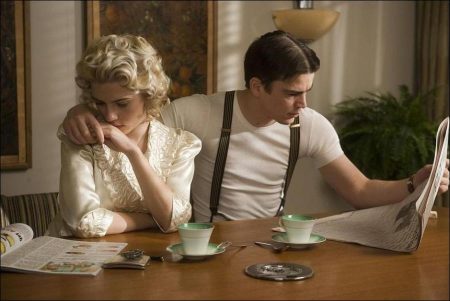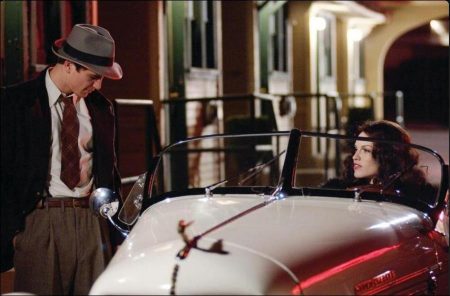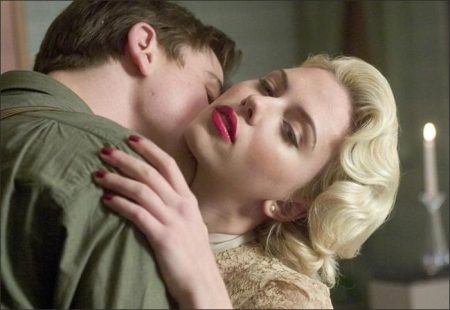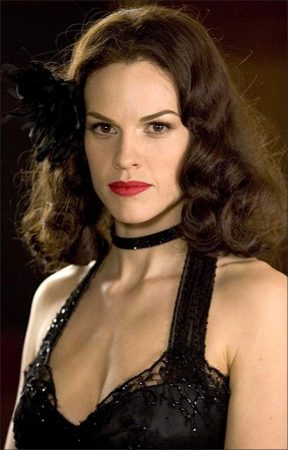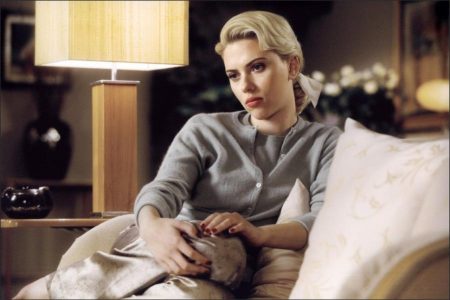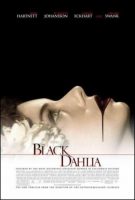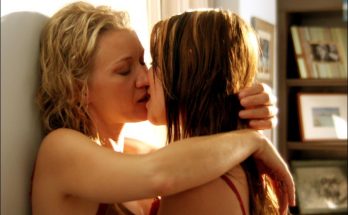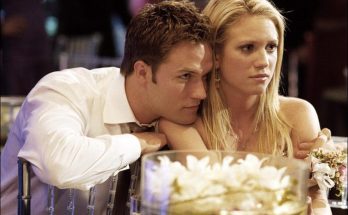The Black Dahlia Movie Trailer. Screenwriter Josh Friedman was originally tasked to hone Ellroy’s 300-plus-page “The Black Dahlia” into a filmable screenplay for director David Fincher—initially attached to the project in 1997—and producers Rudy Cohen and Moshe Diamant. “David and I worked on it off-and-on for several years,” Friedman notes. “I would write a draft, and we would talk about it…then we’d work on other projects.”Eventually Fincher departed the film and, according to Friedman, “Brian De Palma came on, and it was like a locomotive. At Brian and Art’s (producer Linson) urging, we made some significant changes to the script, and we were off.”
Of his source material, the screenwriter offers, “I tend to not think of it as a genre book, but simply as historical fiction. I went with the way Ellroy told the compelling story…he has such a unique way of interweaving. I very much kept to the structure and the attitude of his characters engendered in the book.”
“James creates a whole noir world, and the way he tells his stories is very complex,” director De Palma adds. “His language is so lush. Josh was a very good barometer of what you could and couldn’t do with his work. He lived and breathed Ellroy’s complex, dark material for a decade, forcing the material into Ellroy-ese, never taking the simple route. Art and I worked with him for close to a year before the script was ready to go.”
De Palma acknowledges that he wanted to not just tell the story of the Dahlia but explore the world of fictionalized characters in 1947’s L.A.—those who were profoundly affected by the crime. He responded to Friedman’s interpretation of the “triangle of Bucky and Lee and Kay. There’s a history between Bucky and Lee that goes back to the Zoot Suit Riots and culminates in the first section when Bucky throws a fight in order to get the money to put his father in an old-age home.”
A filmmaker known for plot twists and switchbacks, De Palma also loved that “in the material, everybody lies. In any sensitive dramatic scenes where you think someone’s revealing something, they’re usually revealing the opposite of what they said before. Everybody’s a compromised character, and you watch Bucky descend into this hell and get caught up in it.”
Now comfortable with the screenplay (and suitably financed for overseas distribution), the director and the producers began looking for a domestic distribution partner. A meeting with the then vice chairman (now chairman) of Universal Pictures, Marc Shmuger, would clench the deal and the studio signed on for domestic rights to the film during production.
Producer Art Linson reflects, “It’s a tradition in Hollywood that movies that are dark are hard to get made. What distinguished this from a traditional murder is the effect it had on everyone around it. This movie is not about just about who did it, it’s about the obsession and impact it had on the lives of the LAPD and women connected to these detectives.”
Doppelgangers to Dioptic Cameras
“You’ll never shoot me. Don’t forget who I look like. Because that girl…that sad, dead bitch…she’s all you have.” — Madeleine Linscott
While known for a signature, deft style—one of recurring Hitchcockian themes, doppelgangers, femmes fatales, explosions of operatic violence and sweeping and stalking cameras—the director is the first to laughingly admit that he doesn’t consciously ask, “How can I make this more Brian De Palma?” when he starts a picture. “That’s an unconscious thing. I don’t know why you’re attracted to certain material,” he notes. “There’s just something that hooks you in and intrigues you.”
Still, there are themes to which he finds himself repeatedly drawn. For example, he has long explored the common threads of doubles—both internal and external—those with fractured personalities who transfer guilt onto other characters. It is not uncommon for De Palma’s characters to assume complexities and personalities of others. From Body Double to Dressed to Kill and Raising Cain, he has often explored that territory.
De Palma did find it an interesting fit that many of his recurring themes were echoed in the rapid-fire words and lurid specificity of Ellroy’s world. For example, Madeleine becomes fixated on knowing (and sleeping with) a girl who looks like her, and she falls into the sway and swagger of Betty, beginning to assume her characteristics to seduce others. She even uses Bucky’s obsession with the case to get him to return to her bed. But, as in all adaptations, there would be major cuts to the source material.
During the first reveal of the Dahlia’s crime scene, De Palma focuses the audience on an event (Lee’s shoot-out with Baxter Fitch) that happens simultaneous to the body’s discovery—very much the antithesis of what happens in the Ellroy book.
De Palma thought it would be ironic if the big crime was actually behind the smaller one. “I wanted to completely throw the Dahlia’s reveal away in the background of all those other things going on,” he states. “We had to compress a number of story lines, and we got it down to four herrings. Because most of the story is told through indirection, you think, ‘This is the important thing.’ But in reality, we moved a few of them off the playing field.”
While it was important to the screenwriter and director to bring both Ellroy’s words and intricate subplots into the film version of The Black Dahlia, they knew that the visual medium of film would require some tricks that weren’t available to the novelist. For example, Ellroy poses that Betty’s killer was inspired to carve a grotesque smile onto her face by the story of Victor Hugo’s tragic character Gwynplaine. In Hugo’s 1869 novel “L’Homme qui Rit,” he writes of a man who has a permanent grin carved upon his face by the king, in revenge for the treachery of Gwynplaine’s father. This haunting character has inspired many a film interpretation since the early 1900s (as well as serving as inspiration for Batman cartoonist Bob Kane’s evil antagonist The Joker).
The director notes, “In Ellroy’s book, the image of ‘The Man Who Laughs’ is very much on the murderer’s mind…and the Dahlia is scarred in precisely that manner.” He next asked his team, “What’s the best way to show it? Was there a movie? Sure enough…there was.” De Palma found that showing Bucky, Lee and Kay watching German director Paul Leni’s 1928 film The Man Who Laughs would tie together his loose ends nicely. (Coincidentally, the film was distributed by Universal Pictures and became one of the studio’s first transitional talkies, incorporating sound with cards for the first time).
Few American directors have opted to use the palette of colors and complex camera movements for which De Palma is known. Up until the fight scene between his two supercops, De Palma uses saturation coloring. Then, he moves on to very strong contrasting colors to tell the bulk of his story, complete with desaturated flashbacks. The director notes, “The whole movie is basically a descent into hell. With noir, you try to use high contrast, a lot of shadows and low angles.”
De Palma chose to work with a team—including longtime collaborators, former opera set and Fellini designer Dante Ferretti and renowned cinematographer Vilmos Zsigmond—to design specific sequences in service of the story. The director relates, “I look at a scene, and then I figure out what’s the best position for the camera for a particular piece of action. Then, I maximize the visuals and design the locations for sequences.” Notably, De Palma is known to create three-dimensional models to understand exactly what he wants to film before he starts rolling camera.
Of his directing style, he shares, “It’s not interesting to me unless it speaks to me visually,” he says. “Most directing is quite simple. If you have good taste and know how to direct actors, then you’ll shoot either a medium shot or medium close-up quite well. Unfortunately, most people have been brought up on TV, and many directors offer dialogue with two- and three- and steadicam shots.”
In the film, De Palma keeps images of the Dahlia in the background until the very end, purposefully holding his camera off of close-ups of the body and building the audience’s morbid curiosity and anticipation for what the deceased Betty looks like. He, instead, introduces us to Betty—very much alive—through on-screen camera tests.
De Palma continues, “It was as if someone was displaying a grotesque work of art, then saying, ‘look what I’ve done.’ Those pictures make you think someone was sculpting in flesh. They just seep into your subconscious. My concept was to hold that image back until the end of the film.”
Producer Linson states, “Brian sees the sequences of things visually, and the dialogue is the icing. He brings in the backstory of the Dahlia through screen tests, and he has his own cameo (à la Hitchcock) in there.”
The voice of the off-screen filmmaker who is trying to direct Betty during her test is actually De Palma, originally done as a temporary track, but kept once the production team noted how well Kirshner and the director sparred. De Palma notes, “What you see with Mia during her screen tests was very much ad-libbed. We explored the relationship of my playing a callous, insensitive producer, and Mia, a delusional star-struck, desperate girl. We did a whole series of things on camera, then Vilmos put it into black-and-white. This makes Elizabeth Short a real human being and made the movie much more emotional.”
Continuous takes with the audience-as-participant, another mark of the director, would also be used in The Black Dahlia. The first time the audience is allowed into the Linscott mansion, Swank plays right into the camera in a first-person shoot as we are welcomed in as her date, Bucky. “It’s an old convention of the war,” says De Palma. “This was the place to do it. Let her play her nuttiness right to camera and suck in the audience.” Equally as jarring, as soon as Bucky/audience member sits at the dinner table, the camera switches back to a third-person shot.
It was always De Palma’s intention to use Ellroy’s lines in this scene, noting, “I directed it underlining his intention. This is the craziest dinner one could ever be at, but everybody seems to think everything’s quaint, the way things should be. Only later do we see the deadly consequences of this Addams Family. But when we’re introduced to them, it’s like a Restoration comedy.”
Ground-level camera angles would be used, allowing the audience to look straight from the corpse’s perspective into Bucky’s face when Detective Millard calls him over to view the Dahlia’s body. Switched up again, the audience is Bucky when D.A. Loew dresses down the detective when he’s sitting at his desk.
De Palma and Zsigmond’s choices draw us in even further into Betty’s world, pre- and post-mortem. The complicated camera work needed to follow the fight between Mr. Fire and Mr. Ice would prove not only a physical challenge for Hartnett and Eckhart, but one for cinematographer Zsigmond. As Bucky throws the fight, dropping his right and taking a left hook from Lee—followed by a fast right uppercut that takes out his two front teeth—the camera and choreography work blend beautifully. In this scene and others, De Palma would make much use of his signature split-screen and split-diopter shots.
“In an anamorphic (traditional lens) movie, you see a big face in the foreground and someone 30 feet away, then both of them out of focus,” notes cinematographer Zsigmond. “Optically, it’s impossible to make both clear, so we use a split diopter lens that hides the split and makes the image seamless.” This is also a trademark De Palma imprint, used in films like The Untouchables, Blow Out and Carrie.
Finally, for the Dahlia herself, the production team decided to save sharing the visuals of her body bisected, lying in the lot that would become Leimert Park, until the end of the film. De Palma notes, “We discovered we had to create a living image of the Dahlia. All of the images of her are her dead outside or on an autopsy table. It was a very close replica of the body, and I was always shooting away from it. We only really brought it out in all its glory in the last scene on the lawn.
For audience and filmmaker alike, “the images of her are the things that keep her alive in our imaginations, dreams and nightmares,” he says. “Bucky will always be haunted with this image, much like in my other films where something subconscious grabs you—like Carrie grabbing you from the grave.”
Re-Creating Hollywoodland
“I’m told that I’m very photogenic.” — Elizabeth Short
Ellroy best describes the dark side of Los Angeles as “crime and sex and outré pathology.”
To capture that look for The Black Dahlia, in April 2005, the production team traveled to Sofia, Bulgaria, to re-create Hollywood of 1947. Linson shares, “It was great to have a production crew who maintains the control of duplicating Hollywood. You actually see the Hollywood Hills, but they’re really the hills of Sofia.”
Production designer Ferretti built Hollywood and streets infamous during the Zoot Suit Riots in the Lic Pier/Venice area…locations that no longer exist in L.A. The director adds that he wasn’t concerned about shooting in a location so far from the real Los Angeles, noting, “Much like Scarface, for which we only shot two weeks in Miami, you will never have a sense that you are not in L.A.”
In the book, Lee Blanchard disappears for a time in Mexico, much to the chagrin of Kay and his partner, Bucky. To handle that additional challenge, but still keep elements of the story in play, De Palma brought Lee’s disappearance back to Los Angeles, the city he was re-creating deep within Europe.
The production would actually wrap by shooting key sequences in Los Angeles. During June 2005, the team would film across sections of the city to get just the right look for the backdrops, capturing images indigenous only to L.A. Finally, the production headed to City Hall on Spring Street in downtown Los Angeles to film sequences of the two detectives while they battle with the LAPD to stay on the case. There they would conclude principal photography.
To dress the cast in period fashions, costume designer Jenny Beavan would bring in costumes from London to Bulgaria—specifically, multiple outfits for Swank, Johansson and Kirshner. Beavan succinctly states of the women who wore the fashions of the period, “They defined glamour…even when their lipstick was smeared.”
The director celebrates that his leading ladies were reminiscent of the glamorous era. “Scarlett, Mia and Hilary are dressed to the nines and made up to be as seductive as possible,” De Palma says. “They’re dressed (and photographed) beautifully. You’re defenseless against them.”
Silk flowers, black satin dresses and torn stockings were Beavan’s costumes of choice for the Dahlia. Quite the clotheshorse, Kirshner is known for her love of French clothing from Louboutin to Lanvin.
Johansson found that Kay Lake was indeed a woman with a collection of beautiful clothing. Commenting on her short-sleeve sweater sets, pearls and antique hairpins, she laughs, “How can you not feel like a sexy dish in that?” Specifically, when Bucky comes home to Kay, she opens the door like an angel in white—cut against the disparity of the Dahlia’s black-stained body on the ground with a menacing crow, attacked in death as she was in life.
The men would not be left out. With their wide ties, double-breasted suits and Miller Raider-style teardrop hats, Eckhart and Hartnett were the height of period fashion…even for underpaid flatfoots. Director De Palma adds, “It’s what I loved about The Untouchables. The suits, the hats, the cars and language…everything was so stylized.”
Period-appropriate music was just as vital to De Palma as location or costume choices. From the trumpets that bump in the first time Bucky and Madeleine make love to the slow jazz-band sequence when Bucky reveals a difficult truth to Kay, the score was the evocative creation of composer and jazz trumpet player (and a student of noir films) Mark Isham.
“The key to Mark Isham is that he’s a great trumpet player,” compliments the director. “I always heard a mournful trumpet in this blues type of movie. It was like the voice of Bucky.” He adds, “You know you have a really great composer when he can replace the temp score and you’ve forgotten it completely.”
To underscore the Dahlia’s hideaway, Laverne’s, where she would cage drinks “off the sisters,” the team would turn to unique country and pop-artist belter k.d. lang, whom producer Linson convinced to sing “Love for Sale” for the soundtrack. “We created this kind of Busby Berkeley number,” shares De Palma. “We spent a whole night shooting, and it was the last thing shot in Sofia.”
And what would a sexy, underground ’40s nightclub be without leggy showgirls? Mia Frye, the same choreographer De Palma worked with on Femme Fatale, brought in French, Bulgarian and English dancers to bring Laverne’s to life. “Those girls danced ’til dawn,” laughs the director.
August 30, 2006, marked Brian De Palma’s fifth premiere at the Venice Film Festival. The Black Dahlia opened the annual event in the Sal Grande of Venice’s Palazzo del Cinema. And the inspiration for the story he tells finally found herself on the silver screen, almost 60 years after her murder.
Elizabeth Short’s journey to the movies was a bittersweet one. All her life, she dreamed of being an actress who touched others. She had no idea just how much of a nightmare that would become. A beautiful Hollywood wannabe at the end of the Second Great World War, Betty’s life was snuffed out prematurely. Yet, the impact of her story will be felt for centuries.
The director concludes, “How does that beautiful girl you’ve seen pin-ups of become this? Who did this to her and why? The Black Dahlia has lived on for decades. It’s one of those mysteries that will go on forever.”
We close this chapter of the Black Dahlia’s saga with Ellroy’s summations on Betty and his own mother, Jean: “They rest dead as L.A. opportunists, and I have ceaselessly worked to recast them as L.A. immortals.” Cherchez la femme, Bucky. Cherchez la femme
Afterword Hillikers
Motion pictures pervade the culture far more broadly and immediately than books. It’s a quick-march progression of advance publicity and saturation screen-time. My signature novel is now an exceptional film in wide release. The film will possibly expedite book sales in career-unprecedented numbers. More people may read this afterword than have read all my other books to date. This affords me a narrative opportunity of stern moment. I will gratefully capitalize on it here. A personal story attends The Black Dahlia, both novel and film. It inextricably links me to two women savaged 11 years apart. These women comprise the central myth of my life. I want this piece to honor them. I want this piece to redress imbalances in my previous writings about them. I want to close out their myth with an elegy. I want to grant them the peace of denied disclosure and never say another public word about them.
My mother’s name was Geneva Hilliker. She dropped the name Ellroy when she renounced my father. I laud her repudiation and commend her desire to live without a male surname appendage. She haunts me in deep and unfathomable ways. I often travel her life at a brisk or painstakingly slow mental speed. I start in rural Wisconsin and end on an access road in L.A. The in-between stops are often filled with conjecture. I lived with her for 10 years. The passage of time marks my childhood memories suspect. I later granted her a rich dramatic status and further distorted my memory. I did not know her in life. I am determined to know her in death. Summaries of her 43 years often provide insight. Brevity enhances my process of refraction.
She grew up near the Minnesota border. Tunnel City was summer green and winter dead-tree barren. Her father was an alcoholic game warden prone to violent fits. Her mother was frail and lovely. Her younger sister worshipped her flat-out. A cemetery sits near her birthplace and the now-boarded church she attended. I’ve visited it several times. My ancestry is framed in the bulk of the gravestones. Hilliker, Woodard, Linscott, Pierce, Smith. Farmers and Protestant clergy. A British-American bloodline of longing and hurt that I will never know and will always sense in genetic code.
She had striking dark-red hair. She was the most beautiful girl in Tunnel City. Her aunt Norma Hilliker was the most beautiful woman. She blew out of Tunnel City at 19. She looked back only at leisurely whim. Aunt Norma put her through nursing school in Chicago. She took to city life and succumbed to fleshpot temptations. She drank to excess. She had youthful liaisons. She won a beauty contest and waltzed through a Hollywood screen test. She returned to Chicago. She learned she was pregnant. She tried to abort herself and hemorrhaged. She had an affair with the doctor who patched her up.
She went from “Geneva” to “Jean.” She tied her hair back in a frumpy do and wore it with imperious confidence. She married and divorced a sporting-goods heir in fast measure. She traveled with a much older lesbian sidekick. She moved to L.A. and broke up my father’s first marriage. They moved in together. They lived three miles from the Black Dahlia dump site in 1947. They read about Betty Short and thought about Betty Short and talked about Betty Short in ways that I will never discern.
I was born in ’48. My mother held down nursing jobs and provided support through my father’s feeble stabs at employment. They divorced in ’55. She considered my father weak, fanciful and duplicitous in small ways. She was right. He considered her a drunk and a whore. He failed to acknowledge her competence and dutiful nature. She was Midwestern-Calvinist rectitude and Saturday-night cut-loose girl. She lived in that misalignment. It engendered a desperate unhappiness and killed her.
She met a man. She met him that Saturday night or knew him from before. She was drunk. She said “yes” or “no” or “maybe” or some encoded combination. She said, “No,” finally. He raped her and killed her. It was June 22, 1958.
My bereavement was complex and ambiguous. I lived in her sensual thrall and doted on my permissive father. She was strict. Church was a firm mandate. I caught her in bed with men. I lived for naked glimpses. I hated her and lusted for her and got my wish of her dead.
Her death corrupted my imagination. My reading focus turned to crime stories.
My father bought me Jack Webb’s book “The Badge” for my 11th birthday. It contained a piece on the Black Dahlia murder. Jean Hilliker and Betty Short—one in transmogrification.
I could not openly grieve for Jean. I could grieve for Betty. I could divert the shame of incestuous lust to a safe lust object. I could dismiss Jean with a child’s callous heart and grant a devotional love to Betty.
Jean led me to Betty. Betty led me to Jean. The initial fusing was sharply brief. The sustained process has been attenuated. It’s a torch song with no crescendo and diminishing chords. It’s a near-50-year transit that demands these final words of explication.
I spent the next seven years with my father. I defamed my mother to please him. I grew up hungry for women. I stalked rich neighborhoods and spied on happy families in big houses. I spun Betty Short fantasies. I cast myself in savior and avenger roles. I broke into houses and scoured lingerie drawers. I was born to think single-mindedly and live obsessively. Jean. Betty. Sex. Crime and all its social corollaries. The astonishing conjunctions of deep romantic love—hopeless and hopeful—in fierce men and women. My father died in ’65. I spent the next 12 years in a near-insane spiral. I cleaned up at 29. I wrote six good novels and crashed Betty and Jean with “The Black Dahlia.”
It was a salutary ode to Elizabeth Short and a self-serving and perfunctory embrace of my mother. I acknowledged the Jean-Betty confluence in media appearances and exploited it to sell books. My performances were commanding at first glance and glib upon reappraisal. I cut my mother down to sound-bite size and packaged her wholesale. I determined the cause of my ruthlessness years later.
She owned me. Her claim rankled. I wanted to portray myself as a man above all Oedipal constraints. I had created a fictional Elizabeth Short to usurp my mother’s claim and upstage her. It worked in the novel. It sold a great many books. It left Jean Hilliker still dead on that roadside, unblessed with love.
My moral debt to Jean remained. My moral debt to Betty, too.
I saw my mother’s homicide file in 1994 and wrote a magazine piece about it. I expanded the piece into a memoir entitled “My Dark Places.” The book was my mother’s biography, my autobiography, and the story of my unsuccessful search to find her killer. I addressed my exploitation and gave her to the world with diligence and blunt finesse. It was candor as expression of love and a long-delayed bestowal of honor. I erred only in one manner. I possessed no prophetic gifts. I could not predict the extent to which my mother would shape-shift inside me. I could not predict the influence of two extraordinary women.
They changed me. They constellated and derailed my obsessiveness. They taught me to love with a lighter touch. They convinced me to pull Jean back from my personal dramatic arc and let her rest still in my heart.
“Cherchez la femme, Bucky. Remember that. ”
A prophecy. An obsessed cop’s words to a friend and rival. An indictment and celebration of male ardor. A soft breath in ellipsis.
Jean. Betty. Helen and Joan. Slow, now—go at this softly.
• • •
Baby, who were you? How would you grow and who would you love? Elizabeth Short was born in Boston in 1924. She had four sisters. Her home life shattered early. She left town à la Jean Hilliker and rarely looked back.
She roamed south and west. She landed in postwar L.A. She nursed widespread and undiscerning crushes on young servicemen. She was a more decorous James Ellroy crouched outside bedroom windows.
She was not a porno-film actress or a film noir succubus. She was not promiscuous by any sane standard. She was a pie-faced Irish girl with bad teeth and asthma. She died at 22. The L.A. Herald-Express called her a “romance seeker.” Her last months were a disordered grasp for selfhood and love. I revere her for that. I underestimated her love-hunger in my book. I couldn’t feel it then. My own love-hunger blunted me to the real her. I failed to comprehend the force of her pure and headstrong youth.
I survived my youth. Betty didn’t. That gap defines my debt to her. My gender and native street circumspection spared me the abyss. Betty led with a callow heart. Yearning and a silly girl’s trust took her down. I tried to poise my book between sordidness and goodness. Readers will decide the balance for themselves, in ways I can never assess. I think I know Betty more completely now. I believe her balance tips to goodness in a most fulsome way. A disproportion exists in my portrayal. I filtered the fictive Betty through my own urgent lust. That lust has raged and diminuendoed in the 20 years from book to film. Betty Short was indestructibly hopeful. Her destruction resulted from it. That stands as her tragedy.
Motion pictures pervade the culture far more broadly and immediately than books. Betty was movie-mad and might have sensed this. She had actress dreams. She dressed and coiffed herself with dramatic intent. She killed time in Hollywood movie theatres and subsisted on snack-bar food. She told whopping lies with no small flair. She concocted grand love affairs with doomed Army pilots and stillborn babies. Her stories showed her as the focal point of big lives in duress. She achieved prophecy in that manner. She practiced the conjurer’s art. She envisioned herself as storm center and made her lies come true.
I followed her own lead thusly. I culled physical facts and embellished them. I structured L.A. ’47 as a passion zone subsumed by Elizabeth Short. Every life touches the Dahlia. Betty rocks definitive. Obscurity defined her life. Celebrity defines her death. Her short time span and narrow purview expand and eclipse great public events. Her ghastly end tells us there is no surcease from human horror. She ramifies in obsessive circuits. She bids artists to fuse truths and lies. I followed her lead. Brian De Palma brilliantly followed mine. My novel. His film. My world as his visual record. The Dahlia as lodestone and magnetic field and arbiter of ambiguous redemption.
De Palma’s films circumscribe worlds of obsession. They are rigorously and suffocatingly formed. No outer world exists during their time frame. Colors flare oddly. Movement arrests you. You forfeit control and see only what he wants you to see. He manipulates you in the sole name of passion. He understands relinquishment. The filmgoer needs to succumb. His films are authoritative. He controls response firmly. His hold tightens as his stories veer into chaos. He stands and falls, coheres and decoheres, succeeds and errs behind passion. He was the ideal artist to film The Black Dahlia.
Now Betty Short’s world and my world are his world. It’s a world that no other filmmaker could have created. It’s casually dangerous and invasively corrupt. It’s a boomtown populated by psychically maimed misfits running from World War II. It’s a fiend habitat. The Dahlia was meant to die here and nowhere else. The players in her drama knew relinquishment. They understood that she was bigger than they were, and that by touching her spirit she granted them transcendence. The dynamic applies to me and to Brian De Palma. She’s bigger than us. She tempted us and seduced us and beckoned us to submission. She gave us this grand strain of her endless story.
She touched two men and gave them her world and one man’s journey through it. Bucky Bleichert is a fictional cop and a doppelganger / writer-filmmaker. He’s the man writing out the great adventure of his life and the voyeur viewing sex with a camera. Bleichert is me. Bleichert is De Palma. He’s standing outside momentous events. He’s lost in scrutiny. He wants to control. He wants to capitulate. His inner life is nearchaotic. He needs to impose external order to countermand his mental state. It’s Homicide Investigation as Art. He needs to take malignancy and render it something his own.
Here’s where Bleichert is solely me. He’s a torchbearer. He carries a consuming hurt and tenderness close and doesn’t care if he gets burned. Someone’s out there. It’s a She. I feel her stirring. I need to solve this crime and unlock this riddle and mark this web of circumstance as my own—so she’ll love me.
Crazed. Magnificently fatuous. Hurtful, hopeful, enraged. The reason why I wrote this novel. Misogynistic fury codified. The reason why Betty Short was killed and why I tell redemption tales aimed at women. And why I’m a Hilliker much more than an Ellroy.
“Cherchez la femme, Bucky. Remember that.”
Josh Hartnett understood the precept. His filmic Bucky Bleichert packs that torch for someone out there. The physical Harnett is my described Bucky and me. He’s tall, lanky and dark-haired, with small brown eyes. Hartnett’s performance nails Bucky with no histrionic excess. He excels at projecting cognition. Bucky Bleichert is always measuring and thinking. He’s circumspect, intelligent, watchful. He’s persistent, self-protecting and reluctantly decent. He retains a tenuous dignity as Dahlia mania consumes him. The novel is phrased as a young man coming of age in a hell of his own making. Bucky Bleichert is solely responsible for his own descent. He made specious moral choices early in life and brought a grievously flawed soul to the Dahlia. Hartnett captures that. He appears in every scene and narrates the film. He carries the film’s moral vision. He embodies a positive strain of the Hilliker code: You’re fearful, but you always go forward.
The film spins off the axis of De Palma and Hartnett. It’s a three-mode constellation: thriller/film noir/historical romance. The design is near-German Expressionist. It’s L.A. / it’s not L.A. / it’s L.A. seen by Dahlia fiends in extremis. The cinematographer was Vilmos Zsigmond. The production designer was Dante Ferretti. The costume designer was Jenny Beavan. The film commands you to savor every scene and revel in your visual entrapment. This textual richness symbolizes the Dahlia’s hold on us. We can never look away. She won’t let us.
Scarlett Johansson, Hilary Swank, and Aaron Eckhart backstop Hartnett. They tweak him and crowd him and push him toward his destiny. They meet him in force of performance and somehow retreat—as if they know that he had to take the ultimate fall for Betty and the story is his to tell in the end. Josh Friedman made my story Hartnett’s story and De Palma’s. The essence of my book was forcefully and luminously captured. Friedman knows that obsession is a self-referential madness commonly known as love. It liberates in the short run and finally destroys. Love requires self-sacrifice and deference. Bucky Bleichert learns that and achieves a tenuous peace.
I knew that 20 years ago. I shaped the book around that theme. Knowledge is quite often not power. Dramatic portent does not constitute the will to change. I’m circling back to the lesson of a book I wrote at the tail end of my youth. The lesson is change your life now.
I’ve had splendid teachers. Betty, Jean, those two other women. This essay and the film it celebrates note a conclusion. Betty and Jean continue with me. I want them to remain sans public dialogue. They’ll flourish in silence. It’s a hush they’ve earned. My mother was nine years older than Betty. Her life span stretched 21 years longer. She knew more than Betty. She was a big sister. She had things to teach her. They could have been Saturday-night cut-loose girls together, before Saturday nights cut them down.
That makes Betty a Hilliker. That assigns her a plot in the cold Wisconsin graveyard where I’ll rest one day. It’s my bloodline in repose. Love God. Fear God. Seek goodness as dark forces assail you.
The novel ends with Kay Lake Bleichert pregnant. Bucky travels east for an almost certainly troubled reunion. The year was 1949. Their daughter was born in 1950. She’s 56 now. She’s a sturdy and dutiful woman with narrative gifts. She’s Jean and Betty and me. She’s a Hilliker assuredly.
I won’t state whether Kay and Bucky are still alive. I created them, so it’s my determination. I know, but I’m not telling. The Black Dahlia case continues to unfold in my silence. In that sense, it’s your call.
I would like to thank the many people who served to make my novel such a fine film. I would like to thank Helen and Joan for their great kindness and generosity. “Cherchez la femme, Bucky. Remember that.”
I do. It’s God’s great gift to me and my moral bedrock. I will never forsake that pure thought.
— James Ellroy, San Francisco, 02/27/06
The Black Dahlia (2006)
Directed by: Brian De Palma
Starring: Josh Hartnett, Scarlett Johansson, Aaron Eckhart, Mia Kirshner, Hilary Swank, Fiona Shaw, Mike Starr, Patrick Fischler, John Kavanagh, Anthony Russell, Rachel Miner
Screenplay by: Josh Friedman
Production Design by: Dante Ferretti
Cinematography by: Vilmos Zsigmond
Film Editing by: Bill Pankow
Costume Design by: Jenny Beavan
Set Decoration by: Elli Griff
Art Direction by: Christopher Tandon
Music by: Mark Isham
MPAA Rating: R for strong violence, some grisly images, sexual content and language.
Distributed by: Universal Pictures
Release Date: September 15, 2006
Views: 313
